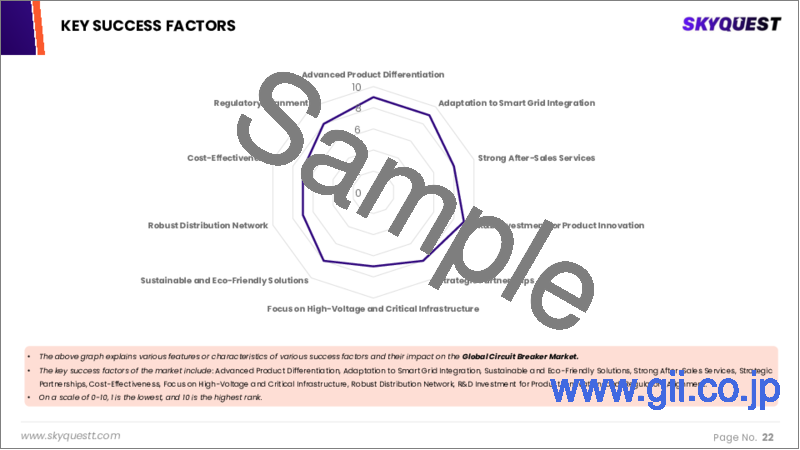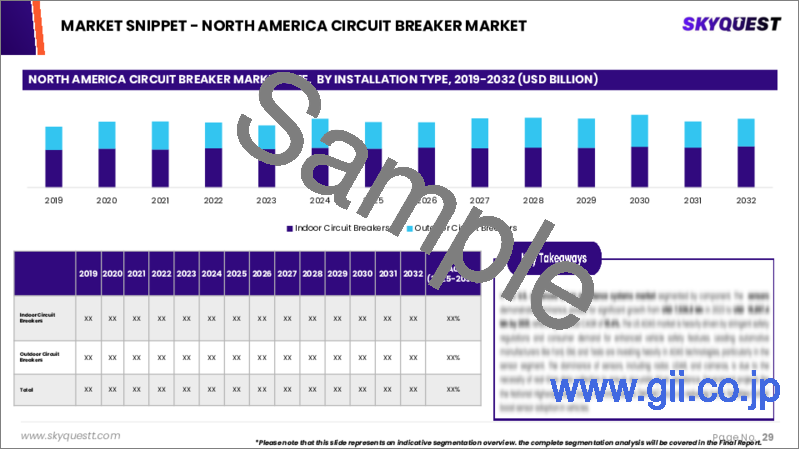|
|
市場調査レポート
商品コード
1539565
サーキットブレーカーの市場規模、シェア、成長分析:タイプ別、用途別、絶縁タイプ別、エンドユーザー別、地域別 - 産業予測、2024年~2031年Circuit Breaker Market Size, Share, Growth Analysis, By Type (Low voltage, High voltage), By Application (Outdoor, Indoor), By Insulation Type (Vacuum, Oil), By End User (T&D Utilities, Power Generation), By Region - Industry Forecast 2024-2031 |
||||||
|
|||||||
| サーキットブレーカーの市場規模、シェア、成長分析:タイプ別、用途別、絶縁タイプ別、エンドユーザー別、地域別 - 産業予測、2024年~2031年 |
|
出版日: 2024年08月12日
発行: SkyQuest
ページ情報: 英文 157 Pages
納期: 3~5営業日
|
- 全表示
- 概要
- 目次
世界のサーキットブレーカーの市場規模は、2022年に約60億5,000万米ドルとなり、2023年の63億6,000万米ドルから上昇し、予測期間(2024年~2031年)のCAGRは5.0%で、2031年までには94億米ドルに達すると予測されています。
サーキットブレーカー業界は、インフラの拡大により電気エネルギーの利用可能性が高まり、住宅、商業、工業の各分野でサーキットブレーカーの需要が高まっているため、大きな成長を遂げています。サーキットブレーカーは、高負荷機器の安全で信頼性の高い動作に不可欠であり、現代の電気ネットワークに不可欠なものとなりつつあります。再生可能エネルギー源の増加、発電投資の拡大、発電所、配電所、送電網間の接続強化などが業界の成長に寄与しています。さらに、生産性と効率を高めるための企業における重機の設置が、市場の拡大を支えています。発電所や公益事業者は、送電網の安全性と信頼性の高い電力供給を確保するため、サーキットブレーカーの採用を増やしています。また、公害や化石燃料の消費を減らすために電気自動車(EV)の利用が拡大していることも、市場の成長を促進しています。しかし、サーキットブレーカー業界は、温室効果ガス排出に関する規制や未組織部門との競合といった課題に直面しています。温室効果ガスの排出で知られるSF6サーキットブレーカーを対象とした規制は、その使用を制限しています。非正規市場のプレーヤーからの競合圧力も、業界の成長を妨げる要因です。こうした課題にもかかわらず、IoTベースのソリューションの台頭により、サーキットブレーカーの市場の可能性は拡大しています。IoTに対応したサーキットブレーカーは、監視と制御の機能を強化し、動作パラメータをリアルタイムで評価できます。この技術により、故障につながる前に問題を検出し、信頼性の向上とコストの削減を図ることができます。また、IoTの統合により、変電所の負荷の継続的な監視が容易になり、データはWiFi経由で制御センターに送信され、市場の成長をさらに後押しします。
目次
イントロダクション
- 調査の目的
- 定義
- 市場範囲
調査手法
- 情報調達
- 二次・一次情報源
- 市場規模予測
- 市場の前提条件と制限
エグゼクティブサマリー
- 市場概要見通し
- 供給需要動向分析
- セグメント別機会分析
市場力学と見通し
- 市場力学
- 促進要因
- 機会
- 抑制要因
- 課題
- ポーターの分析
主要な市場の考察
- 市場の主要な成功要因
- 競合の程度
- 主要な投資機会
- 市場魅力度指数
- エコシステムマッピング
- 技術分析
- サプライチェーン分析
- バリューチェーン分析
- 運用分析
- 特許分析
- 貿易分析
- 価格分析
- 使用事例分析
- 原材料の分析
- スタートアップ分析
サーキットブレーカー市場:絶縁タイプ別
- 市場概要
- 真空
- 空気
- ガス
- 油
サーキットブレーカー市場:電圧別
- 市場概要
- 低電圧
- 中電圧
- 高電圧
サーキットブレーカー市場:用途別
- 市場概要
- 屋内
- 屋外
サーキットブレーカー市場:エンドユーザー別
- 市場概要
- T&Dユーティリティ
- 発電
- 再生可能エネルギー
- 鉄道
サーキットブレーカー市場規模:地域別
- 市場概要
- 北米
- 米国
- カナダ
- 欧州
- ドイツ
- 英国
- フランス
- イタリア
- スペイン
- その他欧州地域
- アジア太平洋
- 中国
- インド
- 日本
- 韓国
- その他アジア太平洋
- ラテンアメリカ
- ブラジル
- その他ラテンアメリカ地域
- 中東・アフリカ(MEA)
- GCC諸国
- 南アフリカ
- その他中東・アフリカ地域
競合情勢
- 上位5社の比較
- 主要企業の市場ポジショニング(2023年)
- 主要な市場企業が採用した戦略
- 市場における最近の活動
- 主要企業の市場シェア(2023年)
主要企業プロファイル
- Siemens AG(Germany)
- ABB Ltd.(Switzerland)
- Schneider Electric SE(France)
- Mitsubishi Electric Corporation(Japan)
- Eaton Corporation plc(Ireland)
- General Electric Company(US)
- Toshiba Corporation(Japan)
- Fuji Electric Co., Ltd.(Japan)
- Hitachi, Ltd.(Japan)
- Legrand SA(France)
- Littelfuse, Inc.(US)
- Rockwell Automation, Inc.(US)
- TE Connectivity Ltd.(Switzerland)
- WEG SA(Brazil)
- Sensata Technologies, Inc.(US)
- Larsen & Toubro Limited(India)
- Havells India Limited(India)
- CHINT Electrics Co., Ltd.(China)
- NOARK Electric(China)
- S&C Electric Company(US)
Global Circuit Breaker Market size was valued at around 6.05 Billion in 2022 and is expected to rise from USD 6.36 Billion in 2023 to reach a value of USD 9.4 Billion by 2031, at a CAGR of 5.0 % during the forecast period (2024-2031).
The circuit breaker industry is experiencing significant growth due to the expansion of infrastructure, which is increasing the availability of electrical energy and driving demand for circuit breakers across residential, commercial, and industrial settings. Circuit breakers are essential for the safe and reliable operation of heavy-load equipment and are becoming integral to modern electrical networks. The rise in renewable energy sources, the expansion of power generation investments, and enhanced connectivity between power stations, switchyards, and the electrical grid are all contributing to the industry's growth. Additionally, the installation of heavy machinery in businesses to boost productivity and efficiency is supporting market expansion. Power plants and utilities are increasingly adopting circuit breakers to ensure grid safety and reliable electricity delivery. The growing use of electric vehicles (EVs) to reduce pollution and fossil fuel consumption is also promoting market growth. However, the circuit breaker industry faces challenges from regulatory restrictions on greenhouse gas emissions and competition from the unorganized sector. Regulations targeting SF6 circuit breakers, known for their greenhouse gas emissions, are limiting their use. The competitive pressure from informal market players is another factor hindering industry growth. Despite these challenges, the market potential for circuit breakers is expanding with the rise of IoT-based solutions. IoT-enabled circuit breakers offer enhanced monitoring and control capabilities, allowing for real-time assessment of operational parameters. This technology can detect issues before they lead to failures, improving reliability and reducing costs. IoT integration also facilitates continuous monitoring of substation loads, with data transmitted via WiFi to control centers, further boosting market growth.
Top-down and bottom-up approaches were used to estimate and validate the size of the Global Circuit Breaker market and to estimate the size of various other dependent submarkets. The research methodology used to estimate the market size includes the following details: The key players in the market were identified through secondary research, and their market shares in the respective regions were determined through primary and secondary research. This entire procedure includes the study of the annual and financial reports of the top market players and extensive interviews for key insights from industry leaders such as CEOs, VPs, directors, and marketing executives. All percentage shares split, and breakdowns were determined using secondary sources and verified through Primary sources. All possible parameters that affect the markets covered in this research study have been accounted for, viewed in extensive detail, verified through primary research, and analyzed to get the final quantitative and qualitative data.
Global Circuit Breaker Market Segmental Analysis
The global circuit breaker market is segmented based on insulation type, voltage, application, end-user, and region. Based on insulation type, the market is segmented into vacuum, air, gas, and oil. Based on voltage, the market is segmented into low voltage, medium voltage, high voltage. Based on Installation, the market is segmented into indoor, and outdoor. Based on end-user, the market is segmented into T&D utilities, power generation, renewables, and railways. Based on region the global circuit breaker market is segmented into North America, Europe, Asia-Pacific, South America, and MEA.
Drivers of the Global Circuit Breaker Market
As the push for clean energy intensifies, there is a growing adoption of renewable sources such as wind, solar, and hydroelectric power. This surge in renewable energy usage is significantly boosting the demand for circuit breakers, which are essential for ensuring the efficient and safe operation of these energy systems. Circuit breakers are vital components in managing and protecting the infrastructure of renewable energy sources. Their role in maintaining operational safety and efficiency within these systems is fueling increased market demand for circuit breakers, reflecting their critical importance in the clean energy sector.
Restraints in the Global Circuit Breaker Market
In developing countries, there is often limited awareness about the advantages of circuit breakers. This lack of understanding can pose a significant barrier to the growth of the circuit breaker market. The market for circuit breakers may be constrained by the insufficient knowledge among consumers regarding their benefits, particularly in less developed regions. This gap in awareness can impede the broader adoption and expansion of circuit breaker technologies.
Market Trends of the Global Circuit Breaker Market
As the demand for energy efficiency and automation increases in residential, commercial, and industrial settings, there is a growing interest in smart and digital circuit breakers. These advanced circuit breakers offer enhanced functionality by enabling communication with other devices and systems, facilitating remote monitoring, control, and diagnostics. The integration of smart and digital circuit breakers enhances safety, boosts efficiency, and improves reliability by providing real-time data and allowing for proactive management of electrical systems. This trend reflects the broader movement towards more intelligent and connected infrastructure solutions.
Table of Contents
Introduction
- Objectives of the Study
- Definitions
- Market Scope
Research Methodology
- Information Procurement
- Secondary & Primary Data Sources
- Market Size Estimation
- Market Assumptions & Limitations
Executive Summary
- Market Overview Outlook
- Supply Demand Trend Analysis
- Segmental Opportunity Analysis
Market Dynamics & Outlook
- Market Dynamics
- Drivers
- Opportunities
- Restraints
- Challenges
- Porters Analysis
- Competitive rivalry
- Threat of Substitute Products
- Bargaining Power of Buyers
- Threat of New Entrants
- Bargaining Power of Suppliers
Key Market Insights
- Key Success Factors of The Market
- Degree Of Competition
- Top Investment Pockets
- Market Attractive Index
- Ecosystem Mapping
- Technology Analysis
- Supply Chain Analysis
- Value Chain Analysis
- Operational Analysis
- Patent Analysis
- Trade Analysis
- Pricing Analysis
- Use Case Analysis
- Raw Material Analysis
- Startup Analysis
Global Circuit Breaker Market By Insulation Type
- Market Overview
- Vacuum
- Air
- Gas
- Oil
Global Circuit Breaker Market By Voltage
- Market Overview
- Low Voltage
- Medium Voltage
- High Voltage
Global Circuit Breaker Market By Application
- Market Overview
- Indoor
- Outdoor
Global Circuit Breaker Market By End-User
- Market Overview
- T&D Utilities
- Power Generation
- Renewables
- Railways
Global Circuit Breaker Market Size By Region
- Market Overview
- North America
- USA
- Canada
- Europe
- Germany
- UK
- France
- Italy
- Spain
- Rest of Europe
- Asia Pacific
- China
- India
- Japan
- South Korea
- Rest of Asia-Pacific
- Latin America
- Brazil
- Rest of Latin America
- Middle East & Africa (MEA)
- GCC Countries
- South Africa
- Rest of MEA
Competitive Landscape
- Top 5 Player Comparison
- Market Positioning of Key Players, 2023
- Strategies Adopted by Key Market Players
- Recent Activities in the Market
- Key Companies Market Share (%), 2023
Key Company Profiles
- Siemens AG (Germany)
- Company Overview
- Business Segment Overview
- Financial Updates
- Key Developments
- ABB Ltd. (Switzerland)
- Company Overview
- Business Segment Overview
- Financial Updates
- Key Developments
- Schneider Electric SE (France)
- Company Overview
- Business Segment Overview
- Financial Updates
- Key Developments
- Mitsubishi Electric Corporation (Japan)
- Company Overview
- Business Segment Overview
- Financial Updates
- Key Developments
- Eaton Corporation plc (Ireland)
- Company Overview
- Business Segment Overview
- Financial Updates
- Key Developments
- General Electric Company (US)
- Company Overview
- Business Segment Overview
- Financial Updates
- Key Developments
- Toshiba Corporation (Japan)
- Company Overview
- Business Segment Overview
- Financial Updates
- Key Developments
- Fuji Electric Co., Ltd. (Japan)
- Company Overview
- Business Segment Overview
- Financial Updates
- Key Developments
- Hitachi, Ltd. (Japan)
- Company Overview
- Business Segment Overview
- Financial Updates
- Key Developments
- Legrand SA (France)
- Company Overview
- Business Segment Overview
- Financial Updates
- Key Developments
- Littelfuse, Inc. (US)
- Company Overview
- Business Segment Overview
- Financial Updates
- Key Developments
- Rockwell Automation, Inc. (US)
- Company Overview
- Business Segment Overview
- Financial Updates
- Key Developments
- TE Connectivity Ltd. (Switzerland)
- Company Overview
- Business Segment Overview
- Financial Updates
- Key Developments
- WEG SA (Brazil)
- Company Overview
- Business Segment Overview
- Financial Updates
- Key Developments
- Sensata Technologies, Inc. (US)
- Company Overview
- Business Segment Overview
- Financial Updates
- Key Developments
- Larsen & Toubro Limited (India)
- Company Overview
- Business Segment Overview
- Financial Updates
- Key Developments
- Havells India Limited (India)
- Company Overview
- Business Segment Overview
- Financial Updates
- Key Developments
- CHINT Electrics Co., Ltd. (China)
- Company Overview
- Business Segment Overview
- Financial Updates
- Key Developments
- NOARK Electric (China)
- Company Overview
- Business Segment Overview
- Financial Updates
- Key Developments
- S&C Electric Company (US)
- Company Overview
- Business Segment Overview
- Financial Updates
- Key Developments





